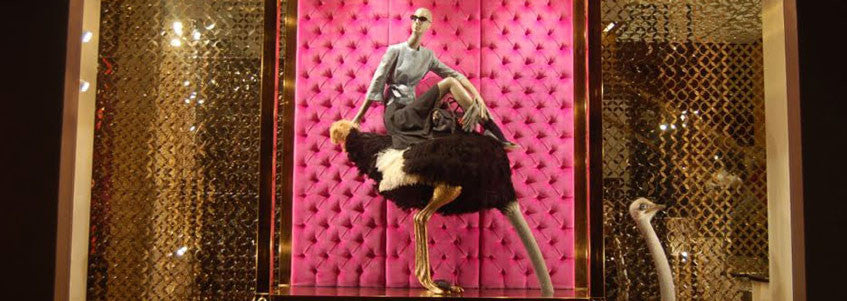Your Cart is Empty
Free Shipping On All Orders In December - No Coupon Code Necessary
Free Shipping On All Orders In December - No Coupon Code Necessary
Free Shipping On All Orders In December - No Coupon Code Necessary
Free Shipping On All Orders In December - No Coupon Code Necessary

September 03, 2016 3 min read
When it comes to mannequin shapes, they have evolved spectacularly over time, from headless Victorian busts to surgical drones. The history of mannequins is as much a history of fashion as an overview of the 20th century. Over the past hundred years, figures change to reflect the advents of window shopping, subversive androgyny, women's liberation, wartime rationing, Barbie doll fetishism, fiberglass, and Twiggy, to name a few. Art deco and Salvador Dali cross the storefront’s path. Shapes rotate from poles to hourglasses and back. Nipples are a subject of debate! There is even legend of a mannequin celebrity.
However, the situation with mannequins now is a lot different: they are 6 inches taller and 6 inches smaller than average women, for instance; most mannequins we see in the shops today are typically a UK size 8-10. Many mannequins are custom made, using contemporary life-real and abstract forms, using – for instance – state-of-the-art sculpting and developing processes that involve 3D modeling techniques for mannequin forms, all while collecting, sorting, recycling and storing re-usable items.
Using The Right Display Tools For The Right Products
Actually, mannequins are increasingly used to display a whole array of products. Dress forms, for instance, are used to display jewelry. A Chanel window display is reinforced by enlarging iconic elements such as pearls and gold chains. In a vintage store, a collection of dress forms versus the smaller jewelry forms makes an impactful display for jewelry.
Also in vintage stores, one may find highly creative and unique displays using mannequins, such as leopard print jewelry stands, elegant body-shaped tie bow hangers (made of high quality laid paper on which is printed an antique Florentine manuscript), beautiful and elegant mannequins made from sturdy heavy gauge painted wire, which are both enchanting and uniquely aged.
There are also paper-based miniature body forms, and they look more like art pieces than displays; these whimsical forms would surely attract everyone’s attention and then move buyer’s direction to the well-deserved jewelry pieces and collections. Furthermore, such wonderful pieces of art can add flare and accent as a home décor as well, because they’re both versatile and eco-friendly.
Display Options: Some Surprising Choices
 Of course, one must not forget display cases, for they can be as important as the mannequin itself. Such mannequin display cases come in any shape, size and color; many companies meet high standards in terms of design, durability, finishes and lighting options. Such cases include rotating cabinets, display stands made in acrylic, as well as the classic glass display cases. Whereas the last may be traditional, modern display cases made of glass actually represent exceptional quality glass units that suit the need of the most demanding clients.
Of course, one must not forget display cases, for they can be as important as the mannequin itself. Such mannequin display cases come in any shape, size and color; many companies meet high standards in terms of design, durability, finishes and lighting options. Such cases include rotating cabinets, display stands made in acrylic, as well as the classic glass display cases. Whereas the last may be traditional, modern display cases made of glass actually represent exceptional quality glass units that suit the need of the most demanding clients.
Let’s not forget custom made display cabinets, such as the ones used for wedding dresses or vintage gowns, some of which are heart-shaped or book-shaped. You enter the store and see an absolutely magnificent gown displayed in a case that opens like a book. What could be more appealing indeed? As for history lovers, they will definitely be fascinated by a late Victorian ebonized mahogany pyramid museum display case, to be seen in a certain museum.
A Lot Of Choices When It Comes To Mannequins & Dress Forms
When it comes to creativity in designing mannequins, some companies have decided to stress on the stance, by choosing to manufacture mannequins with a very wide choice of positions. This not only ensures that displays are more original but allows those who create products a wider range to express their creativity. Other companies try to work with real live models to create mannequins that have real character and impact, followed by photo shoots to explore beyond the obvious to ensure the element of surprise and the originality of the mannequins.
It takes an entire team top manufacture such a mannequin: designers, photographers, sculptors, technicians, 3D graphics experts, couturiers, hairdressers, dressers and stylists. Sculpting ateliers as well as metal, wood and fiberglass workshops, enables manufacturers to cater for the prototyping of all clients’ needs in a minimum amount of time, whether it be mannequins or decoration pieces for displays.
As I have stated before, it has become very important to recycle, to be eco-friendly and reuse as many materials as possible, while remaining unique and attractive. Hence, one may find – at various specialized workshops, fairs or even in shop windows – mannequins and dress forms made of paint chips; wire dress forms decorated with pine tree; mannequins painted with chalkboard to create a fun “guestbook” that everyone will want to sign; custom-made mannequins for glow in the dark or made of grapefruit peel, cantaloupe peels, yellow cedar bark, lotus pod tops, ostrich shell beads and waxed linen.